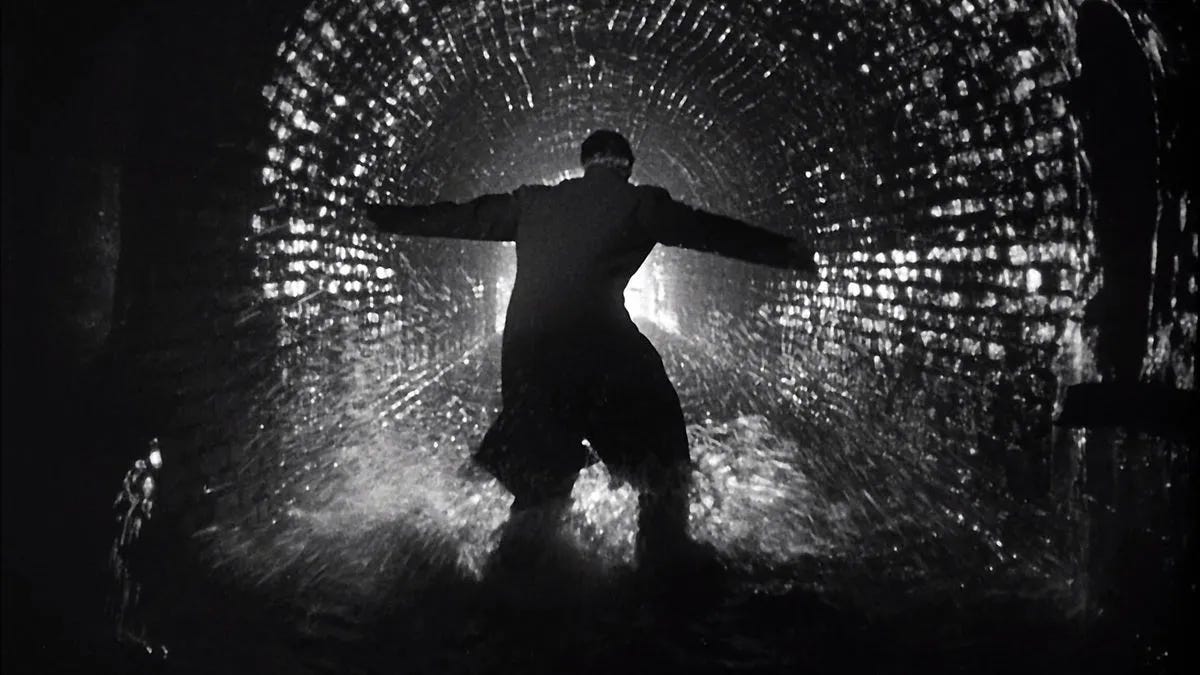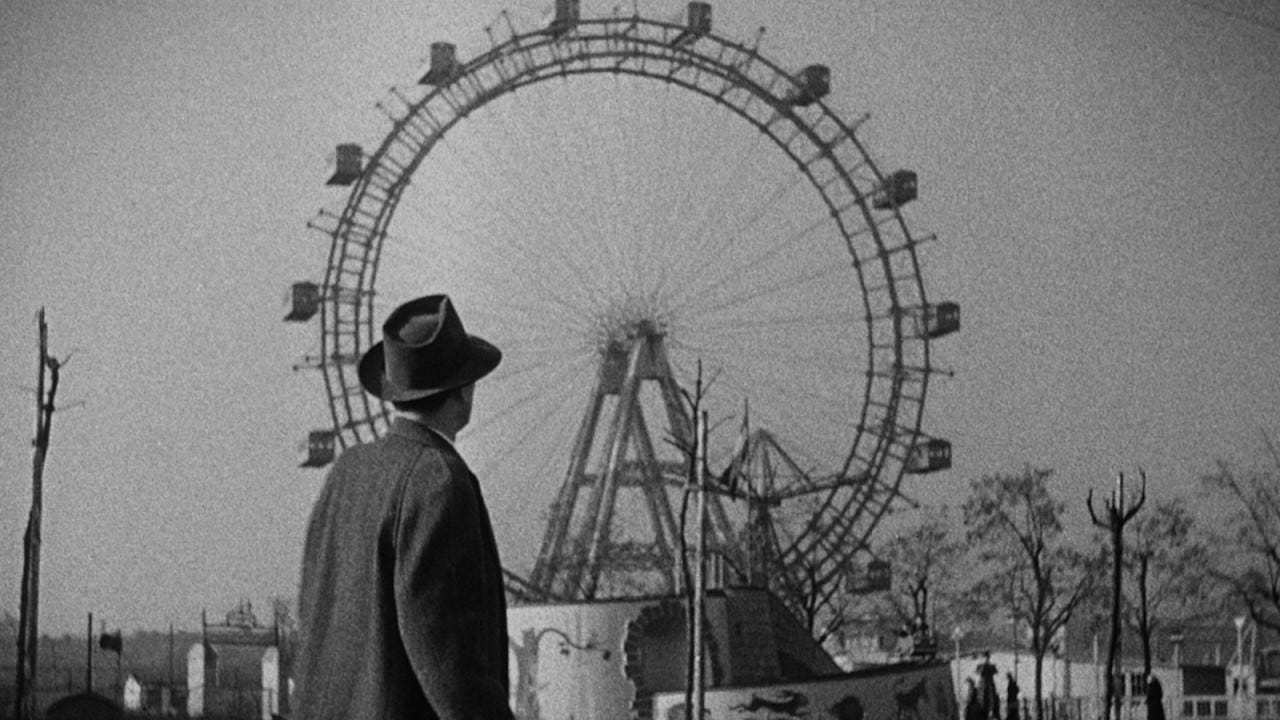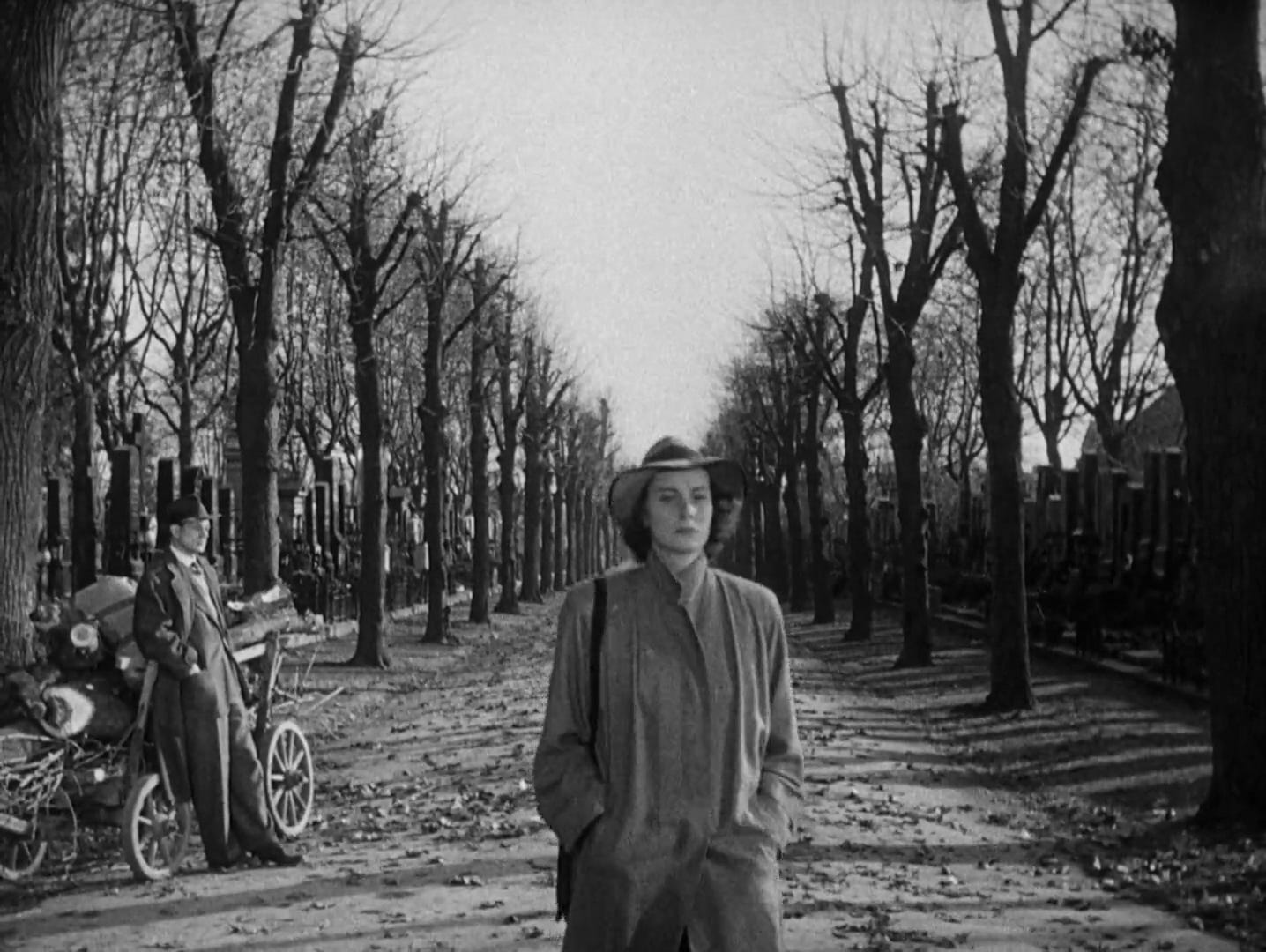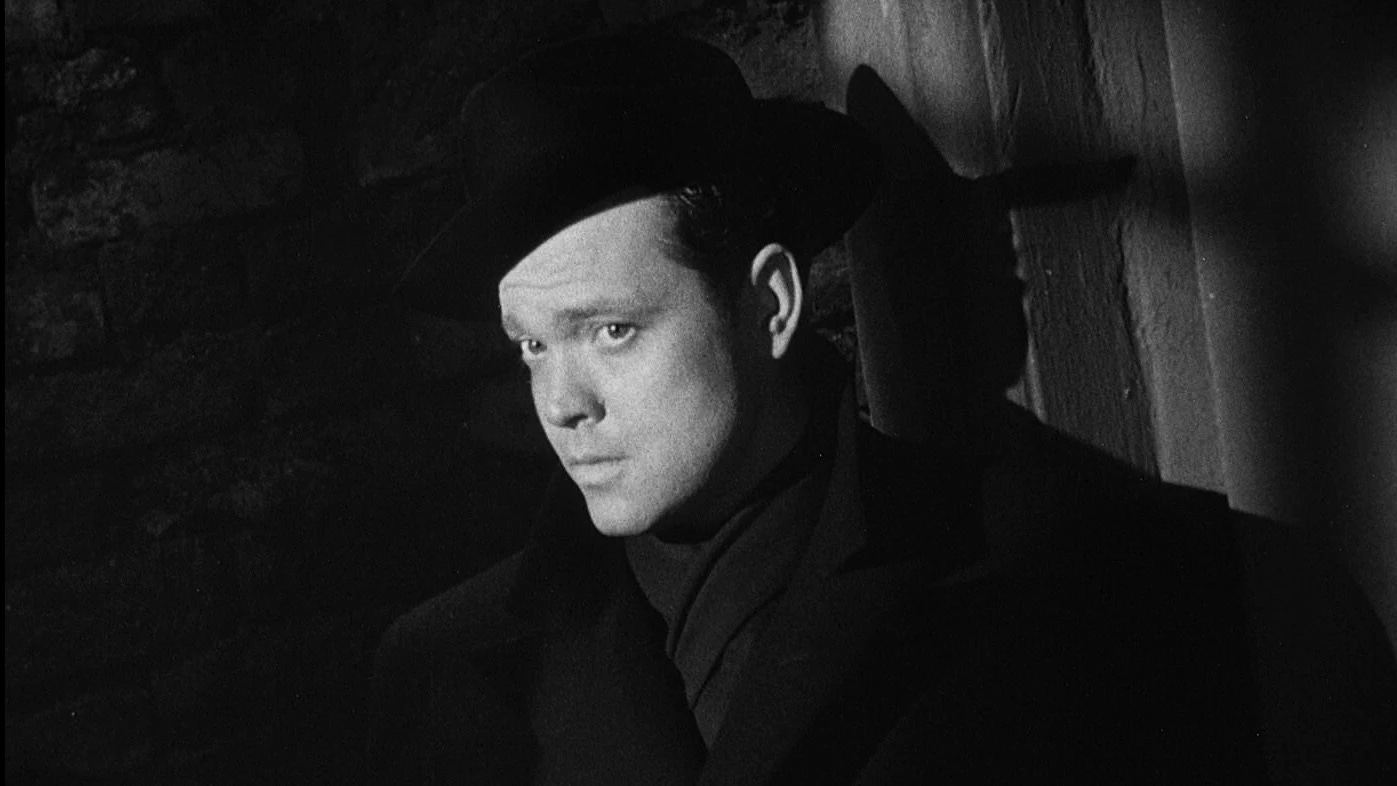#63: ‘The Third Man’: The Reveal discusses all 100 of Sight & Sound’s Greatest Films of All Time
Set against the unforgettable backdrop of post-war Vienna, Carol Reed’s gorgeous film noir brought the genre to new heights.
On December 1st, 2022, Sight & Sound magazine published “The Greatest Films of All Time,” a poll that’s been updated every 10 years since Bicycle Thieves topped the list in 1952. It is the closest thing movies have to a canon, with each edition reflecting the evolving taste of critics and changes in the culture at large. It’s also a nice checklist of essential cinema. Over the course of many weeks, months, and (likely) years, we’re running through the ranked list in reverse order and digging into the films as deep as we can. We hope you will take this journey with us.
The Third Man (1949)
Dir. Carol Reed
Ranking: #63
Previous rankings: #73 (2012), #32 (2002), #42 (1992), #14 (1982)
Premise: In the aftermath of World War II, Holly Martins (Joseph Cotten), a struggling writer of paperback Westerns, travels to Vienna, Austria at the invitation of his old friend Harry Lime (Orson Welles). Shortly after arriving, Holly learns that Lime has died as the result of a car accident. Major Calloway (Trevor Howard), a British officer who’d been investigating Lime, informs Holly that Lime had played a central role in Vienna’s black market. Though Calloway discourages Holly from pursuing the matter further, the writer presses on and, over the course of his investigation, finds himself drawn to Lime’s lover Anna (Alida Valli), an actress with passport problems. Inconsistencies in others’ stories also lead Holly to suspect that Lime may not have died after all.
Keith: When asked about The Third Man and his friend Orson Welles, Peter Bogdanovich liked to repeat Welles’ explanation of why his role in the film, Harry Lime, is “the greatest star part ever written.”:
You know what a star part is? That’s when they talk about you for an hour and then you appear. I did it on the stage, one called “Mr. Wu.” Everybody for the first 45 minutes of the play says, “But what will happen when Mr. Wu gets here?” and “Yes, but what will Mr. Wu say about this?” and “Wait’ll we find out what Mr. Wu thinks.” And everyone boils around the stage, as Orson said, for almost an hour talking about Mr. Wu and just at the end of the first act way in the distance on the stage crossing a bridge comes the small figure of Mr. Wu. And everybody goes, “Ahhh… Mr. Wu.” And the curtain goes down and the audience says, “Isn’t that actor playing Mr. Wu great?”
It’s a fun illustration and true to what Welles does in The Third Man, but only up to a point. Welles doesn’t make his first, fleeting appearance as Lime until deep into The Third Man’s running time. Welles only has one scene with any significant dialogue, an exchange with Joseph Cotten’s Holly Martins that lasts only slightly longer than their ride on the Wiener Riesenrad. Yet as expertly as The Third Man sets up Lime as the film’s center of gravity long before we lay eyes on him, it wouldn’t work if Lime’s big scene didn’t live up to the fanfare.
Harry Lime wasn’t written for Welles but he may as well have been. Welles was the real deal, a one-of-a-kind talent, but wrapped up in that talent was an appreciation for hucksterism, a skill he often used to his advantage. The original trailer for Citizen Kane, for instance, is a tremendous piece of salesmanship. The story of The Third Man is one in which Holly is forced to recognize his old friend for the monster he’s become, but that’s not easy. Lime is a charming and persuasive man, one capable of nudging others into some pretty dark places one inch at a time. I don’t think Holly is swayed by his “Would you really feel any pity if one of those dots stopped moving forever?” argument. But I do think he takes a moment to process the fullness of that argument’s evil and, even then, he still wants to let Lime off the hook. It’s not until he’s forced to look at Lime victims face to face—children dying or driven mad by the diluted penicillin Lime’s been peddling—that he agrees to bring him in. And in the last moment, he kills Lime instead of letting him be taken by the authorities, a mercy Lime doesn’t deserve but one Holly can’t resist giving him.
These elements of The Third Man could play out in just about any location. The film is often, and I think rightfully, classified as a noir and it’s easy to imagine it being a less unusual noir if it played out in, say, New York, with Lime and Holly being old friends from the wrong side of the tracks who reunite after going their separate ways. But the post-war Vienna setting makes it bigger, bringing in historic and thematic weight to transform a small tale of two friends into a bigger story. It’s funny, I don’t think The Third Man has much at all in common with the original Godzilla apart from one moment that always links them in my mind. The scene where Calloway takes Holly to the children’s hospital has an echo in a Godzilla scene that tours a hospital filled with the injured and dying survivors of the big monster’s attack. But in each scene, the victims serve as stand-ins for the recent horrors of World War II. Scale is everything. Lime’s right that you can’t empathize with a moving dot anymore than you can comprehend the loss of millions of lives when they’re rendered as numbers on a page. Confronting the consequences of war face-to-face, however, is another matter.
Scott, there’s a lot to unpack with this film. I’ve barely mentioned Reed’s visual style or Valli or Graham Greene or the zither score or any aspect of Vienna beyond that famous Ferris wheel. Please pick up my slack! But first, I think it bears mentioning that, however weighty its themes, The Third Man is an amazingly zippy piece of entertainment. It’s a mystery that glides from place to place, propelled by witty dialogue and running gags, like Holly being able to stay on because he’s mistaken for a highbrow American author rather than a peddler of adventure tales. Is there a bit of self-awareness there? The Third Man, and those who made it, certainly had careers that straddled both worlds.
Scott: Keith, I’m glad you started with Welles, because I’ve seen The Third Man a few times and between viewings I always forget what a terrible, lethal scoundrel Harry Lime actually is. Much of that is owed to Welles himself, of course, who is so preternaturally self-assured and charismatic in the role that we immediately understand why Holly and Anna remain at least partially devoted to Lime through the bitter end. I think it also speaks to our attraction to antiheroes who project themselves as charming rapscallions rather than sniveling villains. I’d like to imagine Harry Lime referring to human beings as “dots” plays differently through Welles’ lacquered speech than, say, Curtis LeMay ordering the firebombing of Tokyo. Yet the idea is the same: Humans are expendable in the achievement of one’s personal goals. And in both wartime and the post-war milieu of The Third Man, there are opportunities to be gleaned from chaos and destruction.
The whole movie hits like a velvet hammer, though, doesn’t it? And it starts immediately with the opening titles, with the strings plucking along to Anton Karas’ unforgettable zither score, which introduces a tone that’s deceptively light. As you say, it’s a hugely entertaining film that seems to float along as jauntily as the zither music, which isn’t what you would expect from a noir score in that it counterbalances the darkness of the story rather than leaning into it. And that suits Graham Greene’s script, too, which is so deft and witty that you’re caught off-guard by the sinister revelations at its heart. The Third Man is like a suit immaculately tailored around Harry Lime, who is every bit the “star part” Welles describes in that conversation with Peter Bogdanovich you quote at the top. He only has that one big scene—granted, one of the great scenes in movie history—but he’s the tone-setter for the dialogue and the music, and he’s all anyone can think about, right down to the final shot.
You talk about Welles’ appreciation for hucksterism, which is borne out in the essential slipperiness of his persona and in a film like F For Fake, which delights in pulling the rug out from under the audience. I’m reminded, too, of Samuel Fuller’s remarks around his movie Pickup On South Street, when he talked about pickpockets not as criminals but as artists. The world of The Third Man allows such personalities to thrive, because the post-war chaos has created this unique vacuum where black market hucksters can thrive. Vienna is a city cleaved into four zones. There are language barriers everywhere, especially for non-German speakers. (As a side note, I do like how much untranslated German is in the film, just to make that barrier felt by the audience.) Buildings and homes have been damaged, if not entirely reduced to rubble. And so who, in a place like this, is going to stop a man like Harry Lime from taking advantage? That he does not appear to have a conscience opens that many more doors for him, too. If you’re okay with diluting life-saving penicillin reserves for children with meningitis, the sky’s the limit.
I like how Holly Martins isn’t depicted as a white hat, either, despite his talent for writing paperback Westerns. We can see perfectly well how he and Lime could have been friends and how he might tolerate Lime’s less noble qualities. He’s unhappy enough with the news of Lime’s assumed demise that he sticks around after the funeral to turn up a few rocks, all while lucking into that gig to lecture and answer questions about the contemporary novel. (A wonderfully funny scene when it arrives, too. Holly was always going to disappoint a crowd expecting better than a lowbrow author of genre fiction, but he’s so caught up in international intrigue that his performance is worse.) Holly isn’t quite an amoral noir hero, but it does take him a while to do the right thing and he doesn’t get rewarded for it in the end, either.
We haven’t talked yet about the style of The Third Man, which is a big part of enduring appeal. What stands out for you about the look of this film, Keith? Broadly speaking, I appreciated the mix of certain noir characteristics—the single-source lighting techniques, the expressive use of shadows, etc—and an unforgettable sense of place. The Third Man defined Vienna in cinema, to the point where we have a scene in Before Sunrise where Ethan Hawke and Julie Delpy are on the same Ferris Wheel and we might smile in recognition. The other question I have for you: How does Alida Valli’s Anna fit into all of this? She’s not easy to read and I remain a little surprised by her actions at the end of the film.
Keith: You were surprised. Producer David O. Selznick was surprised (and disappointed, wanting Anna and Holly to reconcile). Greene was surprised and pleased. The ending of this film is one of its most memorable scenes, a final punctuation mark that confirms the story we’ve just seen is not one that can be easily or happily resolved, despite Lime’s death. To my eyes, it’s pretty simple: Holly has developed feelings for Anna that Anna does not share. But even if she did, her feelings for Lime would overwhelm any she had for Holly. She’s fully aware that Lime has used her but doesn’t care. Lime used and betrayed her but Holly’s betrayal of Lime makes him even more repulsive to her eyes. It makes no logical sense, but we’re not really operating in the realm of logic. And besides: we spent most of the movie being seduced by Lime ourselves. In the end, however, I can’t help but see her as another victim, and one we’ve gotten to know too well to see as just another dot headed toward an unknown fate.
A side note about Lime: Welles helped give him a kind of afterlife, starring in 52 episodes of the radio serial The Adventures of Harry Lime (a.k.a. The Lives of Harry Lime). These were set before the events of The Third Man and Lime introduced them from beyond the grave. The whole run is available at the Internet Archive and the episodes I’ve heard are pretty fun. It says something that Harry Lime’s appeal survived his exposure as a pitiless destroyer of young lives. But, hey, everyone makes mistakes once in a while, right?
Scott, that’s a really good breakdown of all the stylistic touches used in The Third Man except for one: the Dutch angles. I know we both like to quote our pal Noel Murray when any movie presents the opportunity, so allow me to do the honors: This film has more Dutch angles than a poorly hung Vermeer exhibit. It’s one of the simplest techniques a filmmaker can use, involving nothing more than tilting the camera at an angle. And it looks pretty silly when used recklessly. But when used well, as Reed does here, it creates the sense of a world gone wobbly. Maybe it wouldn’t be as effective in another setting, but paired with shots of a Vienna still visibly scarred by the war, one in which architectural wonders stand next to lots filled with rubble, it's the perfect choice. It also reflects the tonal contrasts you describe above. Reed’s working in the visual language of film noir, but touches like the zither score give the film a regional dialect all its own, much like the polyglot city in which it’s set.
The circle back to the ending of the film, how do you read it? Justice prevails, but The Third Man is an overwhelmingly pessimistic film to my eyes. Lime, an evil man but one who at least made the lives around him more interesting, dies. No bright future awaits Anna. Holly’s left alone in a city where he has no friends and no prospects. (Maybe he can figure out what a “stream of consciousness” is and take a second stab at the lecture circuit?) Their fates feel like extensions of Vienna, and of Europe as a whole. There’s a sense that this four-way split won’t work out in the long run. Maybe it’s the benefit of hindsight and the knowledge the Cold War would only intensify in the decades to come, but The Third Man seems to understand that battles aren’t the only way the forces of history can tear a place apart. For all its romantic allure, Vienna feels like a place that will never fully shed its darkness.
Scott, where do you see The Third Man’s influence? It's undoubtedly evident in subsequent noirs, but I see it just as prominently in the strand of spy fiction that focuses on the personal toll exacted on lives spent in the underworld. That probably has as much to do with Greene’s general influence as his work here in particular. And we should give a nod to how good Cotten is here, too. It’s hard not to get completely overwhelmed when playing opposite Welles but Cotten somehow pulled that off a couple of times. What’s the secret?
Scott: The secret with Cotten, I think, is knowing that you’re not going to draw attention away from Welles. That frustrated other actors who worked with Welles—along with his temperament, which did not improve with age—but Cotten is the lead in The Third Man and he doesn’t have to go toe-to-toe with Welles in order to assert himself. After all, we only get that one major scene between the two of them and he naturally yields the floor to Welles’ Harry Lime. But the film is ultimately about Holly. He’s the audience surrogate. He’s the one affected by his relationships with Lime and Anna. And he’s the one left to pick up the pieces in the end, after coming to Vienna with nothing and somehow leaves with less than what he had. Cotten could give a flashier performance—his “Uncle Charlie” in Hitchcock’s great Shadow of a Doubt springs to mind—but he fits the mold of a noir hero whose emotional turbulence is well hidden under the surface.
I like your reading of the ending, which is indeed almost audaciously bleak. Even though I should immediately recognize film noir as having international roots, given its stylistic connections to the German expressionists, and reflecting a certain post-war cynicism and malaise, The Third Man never springs to mind when I think about the genre because I associate it so strongly with America. Also, this is a David O. Selznick production, which is not a name you associate with a humble crime picture. And then beyond that, The Third Man isn’t merely about the post-war feeling, but a rendering of a specific environment impacted by its destructive force and by the divisions that still scar the world in its aftermath. The story takes place in a city where opportunities for criminal mischief abound, but the elegance of Greene’s screenwriting and the polish of Reed’s direction do not camouflage a prevailing sense of despair. The war is over. Fascism has been defeated. And yet nothing feels settled.
To go back to your notes on style, I of course love those canted angles, which are indeed sparingly yet effectively deployed. One other noir feature here, too, is how empty the city’s exteriors are made to look, as if the population has vanished and only the hearty, nefarious few have some out to play. We would also be remiss not to bring up the sewer system that figures into the thrilling climax, when Lime has scurried like a rat underground and Holly joins the authorities in hot pursuit. The great cinematographer Robert Krasker, who’d worked with Reed on 1947’s Odd Man Out and did some early David Lean films, including Brief Encounter, gets to fill these catacombs with shadows and shafts of light. But the whole setting squares with a story about where business is done in post-war Vienna—and where, in this case, it’s finished.
As for the film’s influence, I think it’s famous enough to have entered the bloodstream of generations of filmmakers who saw it, and you can find appreciation for it online from Martin Scorsese, the cinematographer Ernest Dickerson (who said it informed Do the Right Thing), and others, but I do struggle to think of immediate comparisons. I think there might be something to the fact that The Third Man was both a noir and an Alexander Korda/David O. Selznick production, maybe a classic historical example of what’s referred to now as “elevated” genre fare. Perhaps it remains proof that you could have higher production values while keeping the grimy soul of noir.
Before closing, though, I want to marvel some more at Orson Welles’ introduction, because it synthesizes so much of what’s great about The Third Man—the writing, the filmmaking craft, and Welles at a minimum. The sheer amount of screen time that passes before Harry Lime appears is a marvel in itself, but the elegance with which the introduction is set up is so satisfying, with Anna explaining that the only person her cat liked was Lime. (Again, he’s just that charismatic.) The cat finds its way outside and we also see how the light toggling from the apartment windows can streak through the darkness on the street. And we finally get to that cat rubbing up against a stranger’s shoe in the dark before the light hits Lime and there’s Orson Welles in that hat, who would look great under any circumstances, but has a special allure after so much buildup.
That’s how you do it, right Keith? Any other images from this film you’d like to hang on your wall? And what’s next for us?
Keith: I’ll just add that the expression on Welles’ face completes that introduction brilliantly. It conveys some combination of “Well, you found me” and “Of course I’m not dead” with an undercurrent of playfulness that suggests the carelessness with which he treats a friend who might be grieving his loss. In the end, he just doesn’t care. Lime’s big scene lays the character bare, but it just puts words to what Welles has already made clear in a second or so of screen time.
What’s next? I believe you’re familiar with a director named Martin Scorsese, right? We’ll be talking about his 1990 film Goodfellas. See you in a few weeks.
Previously:
#95 (tie): Get Out
#95 (tie): The General
#95 (tie): Black Girl
#95 (tie): Tropical Malady
#95 (tie): Once Upon a Time in the West
#95 (tie): A Man Escaped
#90 (tie): Yi Yi
#90 (tie): Ugetsu
#90 (tie): The Earrings of Madame De…
#90 (tie): Parasite
#90 (tie): The Leopard
#88 (tie): The Shining
#88 (tie): Chungking Express
#85 (tie): Pierrot le Fou
#85 (tie): Blue Velvet
#85 (tie): The Spirit of the Beehive
#78 (tie): Histoire(s) du Cinéma
#78 (tie): A Matter of Life and Death
#78 (tie): Celine and Julie Go Boating
#78 (tie): Modern Times
#78 (tie): A Brighter Summer Day
#78 (tie): Sunset Boulevard
#78 (tie): Sátántangó
#75 (tie): Imitation of Life
#75 (tie): Spirited Away
#75 (tie): Sansho the Bailiff
#72 (tie): L’Avventura
#72 (tie): My Neighbor Totoro
#72 (tie): Journey to Italy
#67 (tie): Andrei Rublev
#67 (tie): The Gleaners and I
#67 (tie): The Red Shoes
#67 (tie): Metropolis
#67 (tie): La Jetée
#63 (tie): Touki Bouki









When I was in Vienna two years ago I went on a THIRD MAN walking tour, that takes you around to locations used in the film. Some are essentially unchanged all these years later, a jewellery shop you see on a corner in the film is still there! There was a separate storm drain tour but I didn't go on that one, i heard there's really not much to see. Rode on the Prater wheel too of course.
There's also a theatre in the city that shows a matinee of THIRD MAN twice a week, I of course went to that as well after the walking tour so I could go (internally) "I was there! I was there!".
When I was younger, I was always intrigued by the rumors that Welles more or less ghost directed this and I was all the way bought in - the dutch angles! The sharper than hell pacing! The obvious love the camera has for Welles!
But after seeing Odd Man Out, I knew the truth - Reed was a hell of a director with his own thing going. He may have been influenced by Citizen Kane but he brought a ton to this and it is absolutely his picture. IIRC, Welles, never one to exactly shrink away from credit, was always adamant that Reed directed this and he didn't help.
Side note that I think Third Man is a big influence on Touch of Evil - influence is a hell of a thing.